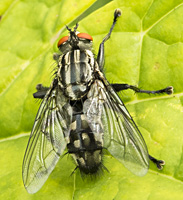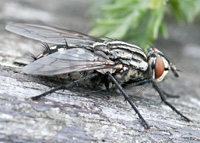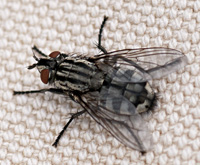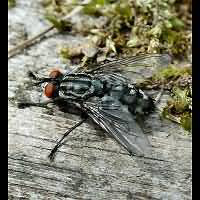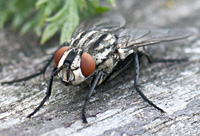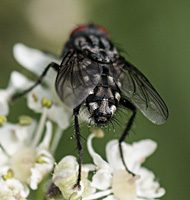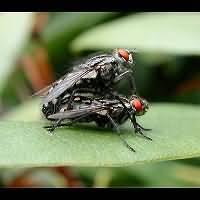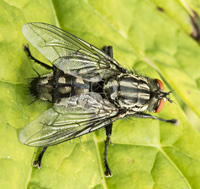[All pictures of garden wildlife on this page are thumbnails. Click on any thumbnail for a large format to be displayed.]

Grey Fleshfly (Sarcophaga sp.)
| Taxonomy | ||||||
|---|---|---|---|---|---|---|
| Kingdom: | Phylum: | Class: | Order: | Family: | Genus: | Species: |
| Animalia | Arthropoda | Insecta | Diptera | Sarcophagidae | Sarcophaga | Sarcophaga sp. |
On the internet usually the Grey Fleshfly is called Sarcophaga carnaria. Unfortunately usually this information is incorrect. In Western European countries the number of species in the genus Sarcophaga varies from 20 to well over 50! All are extremely similar: grey and with chess board markings on the body. You cannot identify them without detailed study of the genitals under a microscope. In insect guides and field guides Sarcophaga carnaria is often shown as the best example of a Grey Fleshfly. Therfore many people think that is the specific fly they have seen. Alas, with at least 20 species around there is no real chance that the identification might prove correct.
Despite the name Fleshfly suggesting somethin connectet to meat, the larvae of most species do not eat decaying meat. Most species deposit their eggs on a carcass. The larvae crawl inside it to hunt for larvae of other insects. The larvae of some species are parasites. The larvae of the true Sarcophaga carnaria for instance are parasites to Earth Worms. Within just a couple of days the worms are eaten from within. Grey Fleshflies do everything in a hurry. The females of some species do not even lay eggs. The eggs hatch inside the mother fly and she gives birth to already living larvae. When conditions are good the larvae may pupate only some 4 to 5 days after their birth. Pupation takes only about 5 days. Thus in less than two weeks there may be a new generation of Grey Fleshflies.
The animals in the pictures all are Grey Fleshflies but we have no single clue about the exact identification. They even could all be the same species, or all be separate species.

© Copyright 1998-2024 gardensafari.net (Hania Berdys)

 English / engels
English / engels  Dutch / nederlands
Dutch / nederlands
